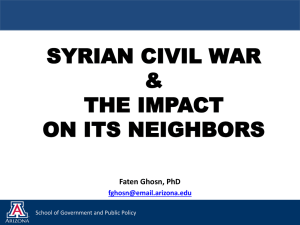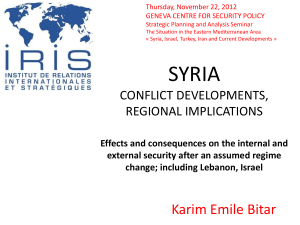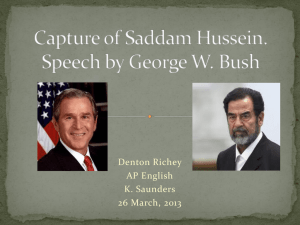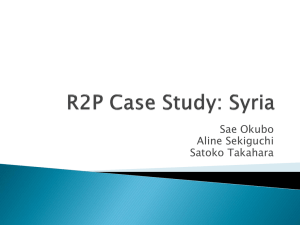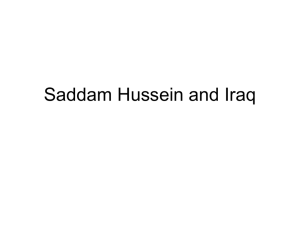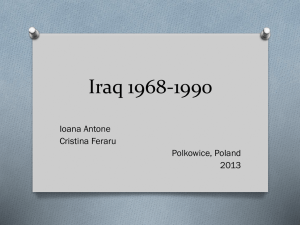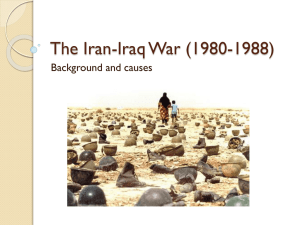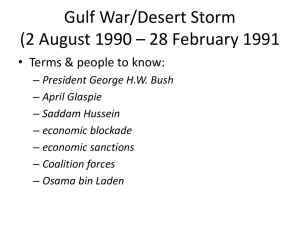the Powerpoint Presentation
advertisement
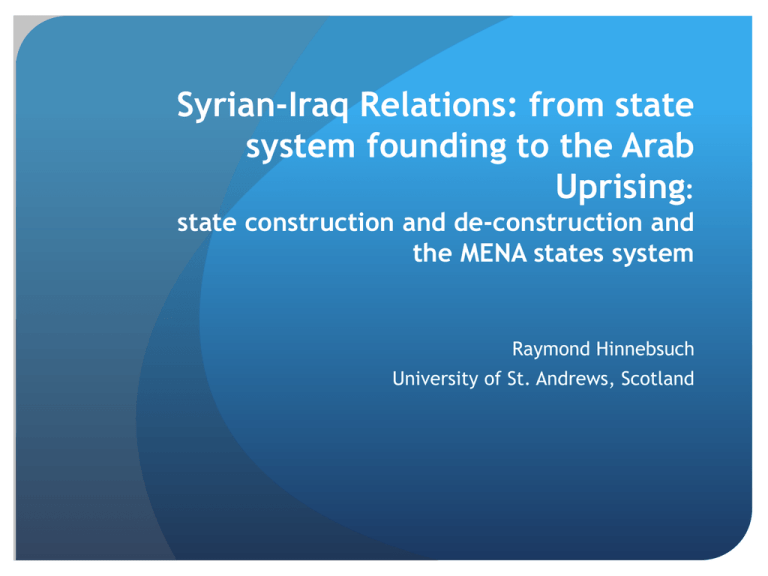
Syrian-Iraq Relations: from state system founding to the Arab Uprising: state construction and de-construction and the MENA states system Raymond Hinnebsuch University of St. Andrews, Scotland Syria-Iraq Relations Theme: the evolution over time, in parallel, of: 1) kind of state 2) features of the states system 3) changes in Syria-Iraq Relations Founding of the states system: Post WWI settlement State Formation:-fragmented states “created to fail” arbitrary borders, Syria arbitrarily divided; Iraq arbitrarily cobbled together, cutting across stronger sub and supra-state identities Regional System: irredentism built in; states highly permeable to trans-state identity movements Relations: borders cut across trade, rivers, identity groupsinterdependencies creating shared interests and vulnerabilities usable against the other Age of Oligarchy: early quasi independence 1940-50 States: oligarchic regimes destabilized by rise of Middle class System: weak states dominated by British hegemon Relations: Struggle for Syria: pro-British Iraq+ Jordan vs EgyptSaudi Arabia. Iraq penetrates Syrian politics, using transstate ties to politicians and army officers Age of Pan-Arab Revolution 1950-70 States: overthrow of oligarchies by military and radical parties Praetorian instability in Iraq and Syria System: consolidated Nasser’s Egypt, model of populist antiimperialist authoritarianism becomes regional hegemonhegemony of Pan-Arabism Bi-polarity allows Nasser to roll back British hegemony Age of Pan-Arab Revolution, 1950-70 Syria-Iraq Relations Dealing with British imperialism: 1954-58: Intensified struggle for Syria, with Egypt vs Iraq over Baghdad Pact rise of Syrian Ba’th, Syrian alignment with Egypt against IraqUAR + Iraqi revolutionend to British hegemony Dealing with Unionism/Nasserism: 1963: Ba’th takes power in Iraq and Syriajoint Pan-Arab leadershi prepares union, congress in Damascus, Iraqi Ba’ play key roles in Syrian politics Pan-Arab Unity negotiations, as Ba’thist Syria and Iraq try to balance Nasser, unity failsBath-Nasser split In struggle with Nasserism, Ba’th falls in Iraq, survives in Syria 1966 Syrian coupBa’th splits into Iraq and Syria branches (issue of unionism or social revolution) Age of Pan-Arab Revolution, 1950-70 Syria-Iraq Relations 1968 Bakr & Saddam seize power in Iraq; Asad in Syriareconciliation turns to rivalry Ba’th dissidents in each ruling Ba’th party seek support from the rival regimemutual transstate subversion via legitimacy wars and recruitment of allies in the other party/army Conclusion: Relations in this period symptomatic of high state permeability; hegemony of Pan-Arabism Age of Realism: War and Oil, 1970-90 States: Consolidation of States authoritarian neo-patrimonial regimes with enhanced bureaucratic, co-optative and military capabilitiesstate stabilization Vulnerability: reliance on sectarian asabiyya and rent States System: States become less permeable to trans-statetoward quasi“Westphalian” states system based on territorial sovereignty Militarized National security (“War” )states e.g. massive Syrian and Iraqi armies “Realist” balancing non-Arab threats (Israel, Iran) via oil-funded arms races and alliances states. Age of Realism: War and Oil, 1970-90 Syria-Iraq Relations Alliance formation expresses transition from Arabism to realsit power balancing Iraq and Syria align against Israel (1973 war); against Sadat’s Egypt (1978); (remnants of Pan-Arab logic) Iraq and Syria split over Iran-Iraq war, Syria balances against Iraq with Iran (conflict of state interests eclipses Pan-Arabism) Conflict conducted via exploitation of mutual trans-state vulnerabilities (not by war, reflective of Syria uses Euphrates water and oil pipelines against Iraq; both foster opposition factions (Iraq backs Muslim Brotherhood 1980s Uprising; Syria hosts Kurdish and Shia dissidents). Rather than subverting the other regime by recruiting Ba’thists in the other, rivals foster religious/ethnic cleavages against by-now fairly cohesive regimes. Age of Post-Populism, US hegemony 1990-2011 States: economic crisis from overdevelopment of war states (war and arms races) +rent declinespostpopulist or upgraded authoritarianismstate social base changes to crony capitalists, foreign investors + mass exclusionsocial bases shrinkrise of Islamist opposition + legitimacy deficits States System: Hegemony of neo-liberalism, spread of economic dependency on West End of bi-polarity US hegemonymost states bandwagon with US Age of Post-Populism, US hegemony 1990-2011 Syria-Iraq relations Divergence of Syria and Iraqi responses to global systemic changes in 1990s: Iraq’s solution to economic vulnerability + decline of USSRinvasion of Kuwait, bid for Gulf/Pan-arab hegemony Iraq war defeat, Iraq under sanctions, continues to defy US Syria’s solution joins anti-Iraq coaltion+ 1990s peace processbandwagons with the US; moves toward integration into world capitalist market Both solutions fail Age of Post-Populism, US hegemony 1990-2011 Syria-Iraq relations Convergence of Syria-Iraq Responses to US Iraq and Syria remain enemies until Bashar al-Asad replaces Hafizrelations transformed sanction-busting oil pipeline deal drives their alignmentSyria opposes sanctions, US drive to war on Iraq; Syria sponsors Islamists’ transit to Iraq to fight occupation, gives refuge to fleeing Iraqi Ba’this and others, notably Iraqi Christians targeted by Islamists. Driving factor: how the weakened Syrian and Iraqi states adapt to (exploit or resist) US/Western penetration of region (from divergence to convergence) Age of State Deconstruction: 1990+ in Iraq, 2011+in Syria Precipitants of State Deconstruction US Invasion of Iraq deconstructs Iraqi statesectarian civil warunleashing of regionwide Sunni-Shia discourse wars, and alliances (e.g. Iran led resistance axis vs. Sunni moderate proWestern axis in 2000s) Syrian Uprisingsectarianization and militarization of the struggleSyria becomes epicenter of regional power struggle framed in sectarian terms Age of State Deconstruction: Symptoms of State Deconstruction Syrian conflict spills into Iraq, symptomatic of trans-state identities(Sunni, Shia) shared by the two states. Western Sunnimajority provinces of Iraq and cross-border tribes back the Syrian uprising, with fighters and arms supply route from Saudi Arabia. Shia militias have joined the fighting for the Asad government- sectarian alliances across state boundaries, i.e. Sunni Islamists opponents against Shia/Alawi dominated governments state loss of sovereignty, territorial control, identity fragmentation Risk of boundary redrawing, undoing of Versailles settlement Age of State Deconstruction Syria-Iraqi relations: dealing with the consequences of state deconstruction in the other Syrian and Iraq governments intervene in the power struggle in the other state, largely on security ground (to weaken or prevent a hostile regime, but they change partners owing to increased sectarian framing of threat. Asad went from opposing the US-backed Iraqi regime and supporting insurgency to accommodation with it and striking alliances with ruling Iraqi factions; e.g in 2010 elections, it allowed Allawi to campaign among Iraqi refugees, but later opted to support Maliki Maliki went from considering Syria responsible for Ba’thist/Sunni Islamist de-stabilization of Iraq to seeing the Asad regime as a bulwark against Sunni Islamists whose victory in Syria would empower his Sunni rivals in Iraq Conclusion: Rise and Fall of state formation 1. Weak oligarchic regimes overthrow by Pan-Arab revolutionspraetorianismtrans-state Ba’thist politics(alliance and rivalries crossing regimes) 2. Consolidation of similar Ba’thist regimesend to trans-state permeabilityrivalry and power balancing against each other 3. Decline of “overdeveloped” war states amidst US hegemonyopposite adaptations (war or peace) both fail 4. State deconstruction under combinations of eternal war and internal rebellion 5. Iraq-Syria epicentres of sectarianizaton of regional system?sectarian reconfiguration of polities? From state construction to deconstruction: the structure-agency puzzle States set up to fail in “Peace to end all peace” (Fromkin) Flawed state building formulas seek to fill the vacuum liberal oligarchies—>too upper class, imperialist dependent Ba’thist populist authoritarianismtoo rent, asabiyya and Pan-Arab dependent-->wars Role of Agency: tragic actors or dyfunctional choices? had Nasser and the Ba’thist shared power in super Pan-Arab state? had Saddam not invaded Kuwait? had Bashar al-Asad not used violence against protestors?

